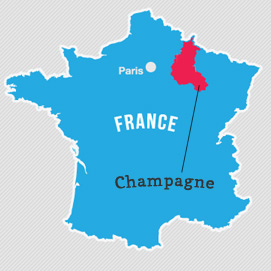Champagne 101
It’s great to love all things bubbly and when it is wine, it’s that much better. But if you ask for ‘Sula Champagne’ or ‘Jacob’s Creek Rose Champagne’ at the store, it is time for an intervention.
Champagne is ONLY from Champagne
First things first. Not all sparkling wine or ‘bubbly’ is called Champagne. The drink can only be called Champagne if it is made in the region of Champagne in North of France, 200kms East of Paris.
The Winemaking
Champagne can only be made using three grape varieties – Chardonnay, Pinot Noir and Pinot Meunier. Anything else in the mix, even if it is made in the region, would not qualify. The process of making this sparkling wine is called ‘Méthode Champenoise’ or the ‘Traditional Method’. In this process, once a base wine is obtained after fermentation, it is poured into a bottle with a little bit of yeast and sugar. This results in a secondary fermentation taking place in the bottle which creates all the bubbles and the characteristic Champagne aromas and flavours.
Decoding the Labels
Champagnes are made with varying degrees of sweetness (a result of the residual sugar).A quick look at the label will usually tell you exactly what to expect.
Extra Brut: A very dry (unsweet) style. Here we are talking about as little as 0-6 grams of sugar per litre.
Brut: This is the most common style of Champagne. Slightly more sugar than the Extra Brut, but still a dry style. Less than 12 gms/litre of residual sugar.
Extra Dry: Sweeter than Brut and a style that many would characterise as ‘semi-sweet’ or ‘off-dry’ because of the sugar content which is between 12 – 17 gms/litre. Just when you thought wine couldn’t get more confusing!
Sec: Much sweeter than Brut and a good introductory wine to those with an uninitiated palate. Residual sugar is between 17 – 32 g/litre.
Demi-Sec: This is a sweeter style of Champagne and works with desserts.
Doux: Having the maximum sugar – more than 50gms/litre.
Date-wise
Unlike with most wines where vintage is key, a majority of Champagne labels carry no mention of the year in which they were made. That is because they are not made from grapes harvested in a single year. These Champagnes are called ‘Non-Vintage’ or ‘Multi-vintage’. Vintage Champagnes do exist though and they are significantly more expensive than the non-vintage ones. Since they are aged longer they are usually more complex in flavour and aroma.
Handling the bottle
The pressure in a single bottle of Champagne is more than that in the average truck tyre. In other words, it can be very dangerous. While opening a bottle, always point it away from yourself and anyone else around.

Serving it right
It has become customary to serve Champagne in flutes since they show the bubbles well. It may look pretty but in truth flutes are terrible to taste the wine. Instead a tulip shaped glass with a wider belly and rim allows more oxygen to mix with the wine and amplifies the aromas which is a big part of a wine. Non-vintage Champagne is best enjoyed at about 8 degrees while vintage ones show well closer to a temperature of 12 degrees. The warmer a wine is the more you taste (up to a certain point), so for a vintage which has more complexity, so slightly less chilled is better.
(This article first appeared on Burrp.com in August, 2014)
